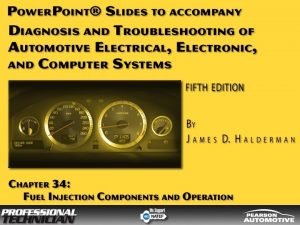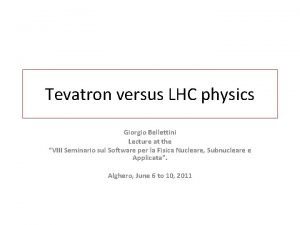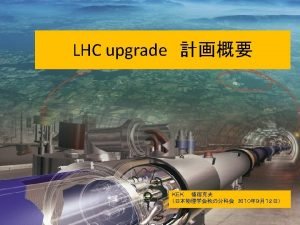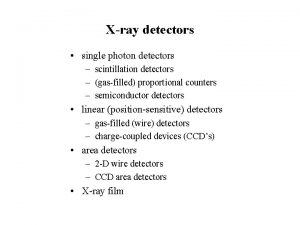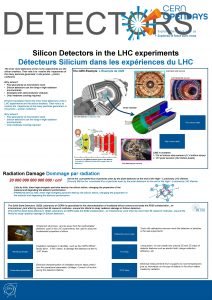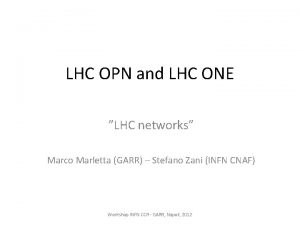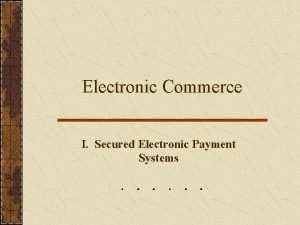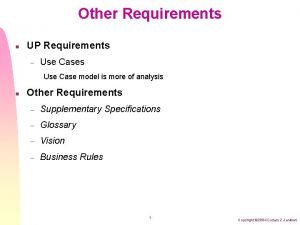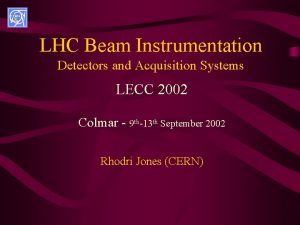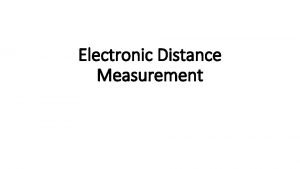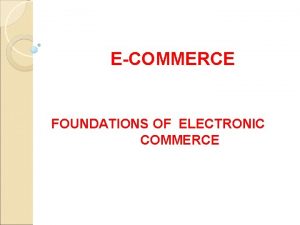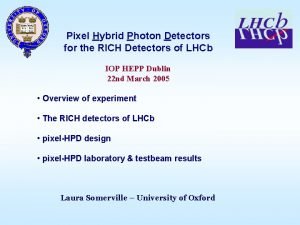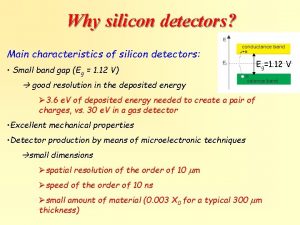Electronic requirements for detectors Use LHC systems to












![Pulse shapes & noise APV 25 • t [ns] • System specification Noise <2000 Pulse shapes & noise APV 25 • t [ns] • System specification Noise <2000](https://slidetodoc.com/presentation_image_h2/64293fbbd9cdb2b7e79de42e504a454d/image-13.jpg)





- Slides: 18

Electronic requirements for detectors Use LHC systems to illustrate physics technical Tracking high spatial precision large channel count limited energy precision limited dynamic range low power ~ m. W/channel high radiation levels ~10 Mrad Calorimetry high energy resolution large energy range excellent linearity very stable over time intermediate radiation levels ~0. 5 Mrad power constraints Muons very large area moderate spatial resolution accurate alignment & stability low radiation levels www. hep. ph. ic. ac. uk/~hallg/ 1 g. hall@ic. ac. uk November 2001

Generic LHC readout system • functions required by all systems amplification and filtering analogue to digital conversion association to beam crossing storage prior to trigger deadtime free readout @ ~100 k. Hz storage pre-DAQ calibration control monitoring • CAL & Muons special functions first level trigger primitive generation • optional location of digitisation & memory g. hall@ic. ac. uk www. hep. ph. ic. ac. uk/~hallg/ 2 November 2001

“Deadtime free” operation • Pipeline memory buffer depth and trigger rate determine deadtime data often buffered in pipeline queueing problem APV 25 NB ≈ 10, NP =192 @100 k. Hz compare with deadtime from maximum trigger sequence = 1001… = 50 ns/10µs = 0. 5% g. hall@ic. ac. uk www. hep. ph. ic. ac. uk/~hallg/ 3 November 2001

Basic radiation effects on electronics • Bipolar atomic displacement Þcarrier recombination in base gain degradation, transistor matching, dose rate dependence • CMOS oxide charge & trap build-up threshold (gate) voltage shift, increased noise, … change of logic state = SEU • All technologies parasitic devices created => Latch-up can be destructive g. hall@ic. ac. uk www. hep. ph. ic. ac. uk/~hallg/ 4 November 2001

Why 0. 25µm CMOS? • by 1997 some (confusing) evidence of radiation tolerance extra thin gate oxide beneficial tunnelling of electrons neutralises oxide charge • negative effects attributed to leakage paths around NMOS transistors cure with enclosed gate geometry g. hall@ic. ac. uk www. hep. ph. ic. ac. uk/~hallg/ 1 Mrad VT vs toxide 5 November 2001

First results from 0. 25µm CMOS (1997) • technology thought to be viable for intermediate radiation levels (~300 krad) but results much better than expected g. hall@ic. ac. uk www. hep. ph. ic. ac. uk/~hallg/ 6 November 2001

Tracking systems • ATLAS • Innermost: Pixels • Inner: Silicon microstrips 6 M channels Occupancy 1 -2% • Outer: Transition Radiation tracker gas filled 4 mm diameter straw tubes 420 k channels x-ray signals from e- above TR threshold occupancy ~ 40% • CMS • Innermost: Pixels • Remainder: Silicon microstrips Occupancy 1 -2% 10 M channels • Radiation hardness is a crucial point for trackers g. hall@ic. ac. uk www. hep. ph. ic. ac. uk/~hallg/ 7 November 2001

ATLAS TRT readout • ASDBLR amplifier/shaper/discriminator • key points speed and stability, since high occupancy peaking time 7 -8 ns => reduce pileup baseline restorer => maintain threshold levels two level discriminator => electron identification g. hall@ic. ac. uk www. hep. ph. ic. ac. uk/~hallg/ 8 November 2001

ATLAS TRT ASDBLR front end • Amplifier =>tail cancellation and baseline restoration selectable for CF 4 and Xe gas mixtures 4 mm straw + Xenon based gas g. hall@ic. ac. uk www. hep. ph. ic. ac. uk/~hallg/ 9 November 2001

ATLAS SCT front end • Amplifier/discriminator + pipeline/sparse readout ABCD (Bi. CMOS) • Binary readout simple small data volume but maintain 6 M thresholds vulnerable to common mode noise • Specifications ENC < 1500 e Efficiency 99% Bunch crossing tag 1 bunch crossing Noise occupancy 5 x 10 -4 Double pulse resolution 50 ns after 3. 5 f. C signal Derandomising buffer 8 deep Power <3. 8 m. W/channel g. hall@ic. ac. uk www. hep. ph. ic. ac. uk/~hallg/ 10 November 2001

CMS microstrip tracker readout • 10 million detector channels • Analogue readout synchronous system no zero suppression maximal information improved operation, performance and monitoring • 0. 25µm CMOS technology intrinsic radiation hardness • Off-detector digitisation analogue optical data transmission reduce custom radiation-hard electronics g. hall@ic. ac. uk www. hep. ph. ic. ac. uk/~hallg/ 11 November 2001

Impulse deconvolution at LHC • High speed signal processing is required to match the 40 MHz beam crossings Low power consumption is essential - 2 -3 m. W/channel Performance must be maintained after irradiation • Start from CR-RC filter waveform weighted sum of pulse samples Ideal CR-RC zero response outside narrow time window small number of weights (>3) implementable in CMOS switched capacitor filter Sampled CR-RC waveform g. hall@ic. ac. uk www. hep. ph. ic. ac. uk/~hallg/ Deconvoluted waveform 12 November 2001
![Pulse shapes noise APV 25 t ns System specification Noise 2000 Pulse shapes & noise APV 25 • t [ns] • System specification Noise <2000](https://slidetodoc.com/presentation_image_h2/64293fbbd9cdb2b7e79de42e504a454d/image-13.jpg)
Pulse shapes & noise APV 25 • t [ns] • System specification Noise <2000 electrons for CMS lifetime ENC [electrons] 1 MIP signal Input capacitance [p. F] g. hall@ic. ac. uk www. hep. ph. ic. ac. uk/~hallg/ 13 November 2001

Calorimeter systems • ATLAS ECAL/Endcap HCAL Liquid Argon 190 k channels signal: triangular current ~500 ns fall (drift time) CD ~ 200 -2000 p. F • ATLAS Barrel HCAL Requirements Scintillating tiles 10 k channels large dynamic range 50 Me. V-2 Te. V = 92 d. B = 15 -16 bits • CMS ECAL precision Pb. WO 4 crystals + APDs (forward: VPT) ≈ 12 bits and high stability 80 k channels precise calibration fast signal t ~ 10 ns CD = 35 -100 p. F ~ 0. 25% Radiation environment few 100 krad - Mrad • CMS Barrel/Endcap HCAL +high neutron fluxes (forward) Cu /scintillating tiles with WLS 11 k channels HPD readout g. hall@ic. ac. uk www. hep. ph. ic. ac. uk/~hallg/ 14 November 2001

CMS crystal ECAL • Amplifier close to photo-detector (APD or VPT) 4 gain amplifier + FPU gain selection 12 bit 40 MHz digitisation commercial bipolar ADC - rad hard • 1 Gb/s optical transmission 12 bit (data) + 2 bit (range) custom development using VCSELs 80, 000 low power links • Recent substantial changes in philosophy g. hall@ic. ac. uk www. hep. ph. ic. ac. uk/~hallg/ 15 November 2001

Optical links in LHC experiments • Advantages c. f. copper: low mass, no electrical interference, low power, high bandwidth • LHC requirements digital control ~40 Ms/s digital data transmission ~1 Gb/s analogue: 40 Ms/s CMS Tracker • Fast moving technological area driven by applications digital telecomms, computer links analogue cable TV requirements c. f. commercial systems bulk, power, cost, radiation tolerance ? ? possible for some applications? g. hall@ic. ac. uk www. hep. ph. ic. ac. uk/~hallg/ 16 November 2001

Semiconductor lasers • Now dominate market, over LEDs narrow beam, high optical power, low electrical power, better matched to fibres • Direct band gap material Ga. As ~ 850 nm Ga. Al. As ~ 600 -900 nm In, Ga, As, P ~ 0. 55 -4µm • Forward biased p-n diode -> population inversion optical cavity => laser at I > Ithreshold often very linear response • Fibres and connectors sufficient rad hardness trackers require miniature connectors care with handling compared to electrical g. hall@ic. ac. uk www. hep. ph. ic. ac. uk/~hallg/ 17 November 2001

CMS Tracker analogue optical links • Edge emitting 1. 3µm In. Ga. As. P MQW laser diodes miniature devices required single mode fibre ~50 m. W/256 detector channels Tx Rx same components for digital control BER << 10 -12 easily achievable g. hall@ic. ac. uk www. hep. ph. ic. ac. uk/~hallg/ 18 November 2001
 Electronic returnless fuel systems use the
Electronic returnless fuel systems use the Where are feature detectors located
Where are feature detectors located Kinesthesis and vestibular sense
Kinesthesis and vestibular sense Feature vectors
Feature vectors Feature detectors
Feature detectors Frontier detectors for frontier physics
Frontier detectors for frontier physics Diagnosing error in object detectors
Diagnosing error in object detectors Photo detectors
Photo detectors Streaming potential
Streaming potential Vhv voltage detectors
Vhv voltage detectors Photo detectors
Photo detectors Nuclear detectors
Nuclear detectors Adsorption chromatography
Adsorption chromatography Giant wave detectors murmurs universe
Giant wave detectors murmurs universe Giant gravitational detectors hear murmurs across
Giant gravitational detectors hear murmurs across Scrip exchange
Scrip exchange Electronic news gathering and electronic field production
Electronic news gathering and electronic field production Bellettini
Bellettini Lhc housing
Lhc housing
